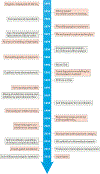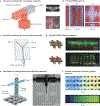Interplay between materials and microfluidics
- PMID: 38993477
- PMCID: PMC11237287
- DOI: 10.1038/natrevmats.2017.16
Interplay between materials and microfluidics
Abstract
Developments in the field of microfluidics have triggered technological revolutions in many disciplines, including chemical synthesis, electronics, diagnostics, single-cell analysis, micro- and nanofabrication, and pharmaceutics. In many of these areas, rapid growth is driven by the increasing synergy between fundamental materials development and new microfluidic capabilities. In this Review, we critically evaluate both how recent advances in materials fabrication have expanded the frontiers of microfluidic platforms and how the improved microfluidic capabilities are, in turn, furthering materials design. We discuss how various inorganic and organic materials enable the fabrication of systems with advanced mechanical, optical, chemical, electrical and biointerfacial properties - in particular, when these materials are combined into new hybrids and modular configurations. The increasing sophistication of microfluidic techniques has also expanded the range of resources available for the fabrication of new materials, including particles and fibres with specific functionalities, 3D (bio)printed composites and organoids. Together, these advances lead to complex, multifunctional systems, which have many interesting potential applications, especially in the biomedical and bioengineering domains. Future exploration of the interactions between materials science and microfluidics will continue to enrich the diversity of applications across engineering as well as the physical and biomedical sciences.
Conflict of interest statement
Competing interests statement The authors declare no competing interests.
Figures






Similar articles
-
Microfluidic Platforms toward Rational Material Fabrication for Biomedical Applications.Small. 2020 Mar;16(9):e1903798. doi: 10.1002/smll.201903798. Epub 2019 Oct 25. Small. 2020. PMID: 31650698 Review.
-
Advancing Tissue Culture with Light-Driven 3D-Printed Microfluidic Devices.Biosensors (Basel). 2024 Jun 8;14(6):301. doi: 10.3390/bios14060301. Biosensors (Basel). 2024. PMID: 38920605 Free PMC article. Review.
-
Synergizing microfluidics and plasmonics: advances, applications, and future directions.Lab Chip. 2025 Feb 25;25(5):1256-1281. doi: 10.1039/d4lc00572d. Lab Chip. 2025. PMID: 39774486 Review.
-
Recent advances in microfluidic-aided chitosan-based multifunctional materials for biomedical applications.Int J Pharm. 2021 May 1;600:120465. doi: 10.1016/j.ijpharm.2021.120465. Epub 2021 Mar 9. Int J Pharm. 2021. PMID: 33711469 Review.
-
High-throughput screening approaches and combinatorial development of biomaterials using microfluidics.Acta Biomater. 2016 Apr 1;34:1-20. doi: 10.1016/j.actbio.2015.09.009. Epub 2015 Sep 8. Acta Biomater. 2016. PMID: 26361719 Review.
Cited by
-
Lab-on-a-Chip Electrochemical Biosensors for Foodborne Pathogen Detection: A Review of Common Standards and Recent Progress.Biosensors (Basel). 2023 Feb 1;13(2):215. doi: 10.3390/bios13020215. Biosensors (Basel). 2023. PMID: 36831981 Free PMC article. Review.
-
Engineering "Endothelialized" Microfluidics for Investigating Vascular and Hematologic Processes Using Non-Traditional Fabrication Techniques.Curr Opin Biomed Eng. 2018 Mar;5:13-20. doi: 10.1016/j.cobme.2017.11.006. Epub 2017 Dec 5. Curr Opin Biomed Eng. 2018. PMID: 29756078 Free PMC article.
-
Anti-smudge superhard transparent coatings via ultra-small nanoparticle pattern surfaces.iScience. 2025 Feb 12;28(3):111996. doi: 10.1016/j.isci.2025.111996. eCollection 2025 Mar 21. iScience. 2025. PMID: 40092618 Free PMC article.
-
Advances and Applications of Micro- and Mesofluidic Systems.ACS Omega. 2025 Mar 25;10(13):12817-12836. doi: 10.1021/acsomega.4c10999. eCollection 2025 Apr 8. ACS Omega. 2025. PMID: 40224426 Free PMC article. Review.
-
3D bioprinting of collagen-based high-resolution internally perfusable scaffolds for engineering fully biologic tissue systems.Sci Adv. 2025 Apr 25;11(17):eadu5905. doi: 10.1126/sciadv.adu5905. Epub 2025 Apr 23. Sci Adv. 2025. PMID: 40267204 Free PMC article.
References
-
-
Whitesides GM The origins and the future of microfluidics. Nature 442, 368–373 (2006).
A comprehensive review of the background, applications and future perspectives of microfluidics.
-
-
- Bhatia SN & Ingber DE Microfluidic organs-on-chips. Nat. Biotechnol 32, 760–772 (2014). - PubMed
